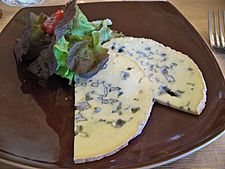Fourme d'Ambert facts for kids
Quick facts for kids Fourme d'Ambert |
|
|---|---|
 |
|
| Country of origin | France |
| Region | (Puy-de-Dôme), Auvergne |
| Town | Ambert |
| Source of milk | Cow |
| Pasteurized | Depends on variety |
| Texture | Semi-hard |
| Aging time | 1-4 Months |
| Certification | AOC 2002, PDO 1996 With Fourme de Montbrison since 1972 |
| Named after | Lua error in Module:Wikidata at line 70: attempt to index field 'wikibase' (a nil value). |
Fourme d'Ambert is a famous French blue cheese. It's known for its special blue veins and soft, creamy texture. This cheese comes from the Auvergne region in France and is one of the oldest cheeses in the country, dating back to ancient times. It has a unique tall, narrow shape.
Contents
A Taste of History
Fourme d'Ambert is one of the oldest cheeses from France. Some people believe it has been made since Roman times. A sculpture of this cheese can even be seen above the entrance of a medieval chapel in La Chaulme. This shows how important it has been for a very long time.
How Fourme d'Ambert is Made
This special cheese is made from cow's milk. To give it its blue veins, tiny spores of a special mold, called Penicillium roqueforti, are added to the milk. After the cheese is shaped, it needs to age. This aging process takes at least 28 days. During this time, the mold grows and gives the cheese its unique flavor and blue color.
Fourme d'Ambert and Fourme de Montbrison
For many years, Fourme d'Ambert was considered almost the same as another cheese called Fourme de Montbrison. From 1972 to 2002, they even shared the same special protection, called an AOC. This AOC is a French label that protects the name and quality of certain foods. In 2002, both cheeses were recognized as separate types. They have small differences in how they are made.
Different Ways of Making Fourme
Most Fourme d'Ambert cheese is made by large companies or cooperatives. They often use pasteurized milk, which means the milk has been heated to kill germs. However, some people are now making this cheese in a more traditional way.
- Artisanal production: This means the cheese is made by skilled craftspeople, often by hand. They might use raw milk, which has not been pasteurized.
- Farm production (Fermière): This type of Fourme d'Ambert is made right on the farm where the cows live. It also uses raw milk from those specific cows. Currently, only a few farmers make this special "fermière" version.
See also
 In Spanish: Fourme d'Ambert para niños
In Spanish: Fourme d'Ambert para niños

